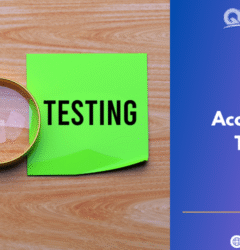20 Mar

Introduction
In this blog, we are going to understand Stress testing, which is an important part of Performance testing and is used to check the behaviour of the website or an application by applying a load greater than the convenient load.
And also, learn about its process, why we need to perform Stress testing , the objective of Stress testing , the need for Stress Testing the goals of Stress Testing , types of Stress Testing , how to do Stress Testing, tools recommended for Stress Testing , metrics for Stress Testing, advantages and disadvantages of Stress Testing and conclusion.
What is Stress Testing?
Stress Testing is a type of software testing that verifies the reliability & stability of software applications. The goal of Stress testing is to measure software on its robustness and error handling capabilities under extremely heavy load conditions and ensure that software doesn’t crash under disaster circumstances. To analyze how the system works under extreme conditions, We perform stress testing outside the normal load.
In Software Engineering, Stress Testing is also known as Endurance Testing, Torture Testing, or Fatigue Testing. Under Stress Testing, AUT is stressed for a precise period to know its withstanding capacity. The most outstanding use of stress testing is to determine the limit, at which the software or system, or hardware breaks. Also, it checks whether the system demonstrates effective error management under severe conditions.
Need for Stress Testing
Consider the below real-time examples where we can catch the usage of Stress Testing –
·
During festival time duration, an online shopping site may witness a spike in traffic, or when it announces a sale or offer.
· When results are announced for any board or university it experiences a sudden surge in traffic.
It is compulsory to perform Stress Testing to hold such abnormal traffic spikes. Failure to hold this sudden traffic may result in a loss of revenue and prestige.
Stress testing is also highly valuable for the following reasons:
·
Displaying relevant error messages when the system is under stress.
·
To check whether the system works under unexpected conditions.
·
It is better to be prepared in advance for severe conditions by executing Stress Testing.
·
System failure under severe conditions could result in huge revenue loss.
Goals of Stress Testing
The goal of executing the stress testing is to confirm that the software does not crash in lacking computational resources like memory, disk space, and network requests and to figure out the behavior of the system after a failure.
The main goal of stress testing is to ensure that the system recovers after failure which is called recoverability.
Stress testing will help us to verify the security weaknesses that might sneak in throughout the constant peak load.
We can use stress testing to catch hardware issues and data corruption issues.
Stress testing helps to complete the software application’s data integrity throughout the severe load, which implies that the data should be in a steady state after a failure.
Types of Stress Testing
Following are the types of stress testing with explanations:
1. Product or Application stress testing
The application or product stress testing is mainly focused on determining the faults related to network issues, data locking, blocking, and performance bottlenecks in a software product.
2. Server-client or distribute Stress Testing
In this type of stress testing, all the clients related to the server are tested and the distributed stress testing is used to perform across all clients from the server.
The server can communicate with clients W and X, but it cannot link with clients Y and Z when there is stress on the client-server system.
3. Analytical/Exploratory Stress Testing
Analytical/Exploratory stress testing is performed to test the system with abnormal parameters or conditions that are unlikely to happen in a real scenario. It is carried out to find defects in exceptional scenarios like a large number of users logged at the same time or a database going offline when it is approached from a website.
4. Systematic Stress Testing
Systematic stress testing is integrated testing that is used to execute tests across multiple systems running on the same server. It is used to disclose defects where one application data blocks another
application.
5. Transactional Stress Testing
Transaction stress testing is executed on one or more transactions between two or more applications. It is carried out for fine-tuning and enhancing the system.
How to do or how to perform Stress Testing
The stress testing process will be completed in the below steps:
Step 1: Detect the testing environment
In this first step of stress testing, we will identify the network, hardware configurations, software, and tools available to achieve the stress test.
Step 2: Find performance acceptance criteria
After determining the testing environment, we need to find the performance acceptance criteria, which help us classify the metrics used to test the application’s performance under stress.
And also, classify the success criteria for a stress test, for example, the maximum load that can apply to the application for it to fail.
Step 3: Plan and design stress tests
In this step of the stress testing process, we need to plan and design a stress test plan, identify test scenarios, etc.
Step 4: Configure the test environment
After the stress test plan has been created successfully, we need to move to our next step where we need to create the test environment, resources essential, and tools to perform each path as features and components
become available for testing.
Step 5: Implement test design
After the test environment’s configuration is done, we need to develop the stress tests resulting in the test design’s best performance.
Step 6: Execute tests
In this step, we need to execute the particular test and observe and verify the tests along with test data and output collection.
Step 7: Analyze the results
In this last step of the stress testing process, we need to figure out the outcomes, combine them and share the respective teams’ output data.
Tools Recommended for Stress Testing
LoadRunner
LoadRunner from HP is a generally used Load Testing tool. Load Test Results formed by LoadRunner are considered a benchmark.
Apache JMeter
JMeter is an Open-Source testing tool. It is a pure Java-based application for Stress and Performance Testing. JMeter is planned to cover types of tests like load, stress, functional, etc. It needs JDK 5 or higher than this to function.
Neo load
Neo load is a popular tool available in the market to test Web and Mobile applications or software. This tool can simulate thousands of users to check out the application performance under load and figure out the response times. Also, it is supporting Cloud-integrated-performance, stress, and load testing. It is easy to use, cost-effective or profitable and brings good scalability.
Stress Tester
The Stress Tester tool brings extensive analysis of the web application performance, gives results in graphical format, and it is quite easy to use. No high-level scripting is required and provides a good return on investment.
Metrics for Stress Testing
Metrics help in generally studying at the end of the Stress Test and evaluating a System’s performance. Generally, used metrics are:
Pages Per Second: Measures how many pages have been requested and loaded per second.
Pages time: Average time taken to retrieve all the information on a page.
Time to the First Byte Retrieved: Average time taken to return the first byte of data or information.
Transaction Response Time: Average time taken to perform or load transactions between the applications.
Transactions per Second: It takes a count of the number of transactions loaded per second and counts the number of failures that occurred.
Failed Connections: It takes count of the number of failed connections refused by the client in their system.
Failed hits: It takes count of the number of failed attempts in the system.
Failed Rounds: It takes count of the number of script or test conditions executed by the clients successfully and it retains track of the number of rounds failed.
Advantages and Disadvantages of Stress Testing
Advantages of Stress Testing:
Stress testing determines the behavior of the system after failure and makes sure that the system recovers rapidly.
Stress testing makes the system work in natural as well as unnatural conditions in an appropriate way.
Stress testing makes sure that system failure doesn’t cause security issues.
Disadvantages of Stress Testing:
The manual process of stress testing takes more time to complete and it is a bit complicated process.
There is a requirement for external resources to implement stress testing. It leads to an extra number of resources and time.
Great scripting knowledge for implementing the script test cases for the particular tool is needed.
The licensed stress testing tool case charges higher than the average amount cost.
In some open-source tools cases, there is a required load testing tool additionally for setting up the stress testing environment.
If appropriate test cases or stress scripts are not implemented then there will be a chance of failure of some resources and diffusion of time.
Conclusion:
In this blog, we have understood that stress testing is used to check the system under severe situations. It can identify the system to recover back to normal status and it is a type of non-functional testing and is usually executed after the functional testing.
Stress testing entirely concentrates on testing the system under severe load situations to detect its breaking point and see if relevant messages are shown when the design is not responsive.
QACraft is one of the leading software testing companies. We provide all kinds of software, mobile, and web app testing services, so if you are planning to hire the best software testers, Hire us now.
I am Priyanka Kantharia. I am working as a Software Test Engineer at QACraft. My Qualification is MCA. I have 4 years of work experience as a QA. My hobbies are watching movies, and listening music.
Related Post
Leave a Comment Cancel reply
Categories
- Agile Testing
- Alpha Testing
- Android App Testing
- API Testing
- Automation Testing
- Banking Domain Testing
- Beta Testing
- cloud testing
- Corporate Life
- cross browser testing
- Cypress Testing
- desktop testing
- Difference
- Domain Testing
- E-commerce Website Testing
- E-learning App Testing
- End-To-End Testing
- Functional Testing
- Game Testing
- Healthcare Domain Testing
- Integration Testing
- Interview Questions
- ios App Testing
- Jenkins
- JIRA
- Jmeter
- K6
- Katalon
- Manual Testing
- Mobile App Testing
- Monkey Testing
- Non-Functional testing
- Performance Testing
- Postman
- Pytest
- Regression Testing
- Salesforce Testing
- Sanity Testing
- security testing
- Selenium Testing
- Smoke Testing
- Software Testing
- Stability testing
- Static Testing
- Test Case
- Test Environments
- Test Scenario
- Test Script
- TestRigor
- vdfv
- Web Application Testing
© Copyright 2025 QACraft Pvt. Ltd. All rights reserved.
Contact : +91 9157786796




Priyanka Kanthariya